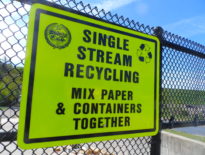In August federal Bills on plastic pollution and Zero Waste were put forward in Congress by Senator Tom Udall (D-N.M.) and Representative Alan Lowenthall (D-Calif.) and Representative Ilhan Omar (D-Minn.).
Neither can come close to moving forward given the make-up of the Senate and the veto power of the president. Yet they can establish a blueprint for progressive steps in the future. However, some fine-tuning is needed to ensure that well-intentioned legislation does not actually make it harder to move forward toward recyclers’ goals.
The Udall/Lowenthall and Omar bills are complementary.
Plastics
The Udall/Lowenthal bill introduces a series of possibly transformative elements. These are:
- Extended producer responsibility (EPR). As a condition of sale, producers will be required to design, manage, and finance end-of-life programs for products and packaging. Industry will also be incentivized to develop more sustainable alternatives.
- Nationwide container deposit requirements. Non-refunded deposits would go into a federal fund to assist with collection infrastructure. Major beverage retailers would be required to install and operate reverse vending systems to promote container collection.
- Carryout bag fee. The fee would be deposited into a federal fund.
- Single-use plastic bans. The ban would apply to items such as expanded polystyrene, bags, cups, lids, cotton buds, cutlery, plates, straws, packaging, and stirrers. Exceptions will be made for individuals with disabilities until adequate alternatives are developed.
- Labeling requirements. Plastic consumer products would require clear, standardized labeling indicating correct disposal method.
- Awareness-raising measures. States would be encouraged to educate consumers on the impact of single-use plastics as well as available reuse systems and waste management options.
- Recycling targets. Standardized single-use plastic bottle collection targets would be established for states and communities. A requirement would also be set for bottles, packaging, and other products to be made from 100% recyclable materials.
- Federal waste reduction assistance. Proceeds from a federal fund, carryout bag fees, and unused container deposit requirements and other sources would go toward pollution reduction, remediation programs, and innovation research.
- “Clean Cities Program.” The program would use smart technologies and social media to help local governments identify pollution hotspots and implement source reduction solutions.
The call for a federal EPR system and a national bottle bill are the most important features of the bill. Perhaps a federal ’bottle bill’ can break the impasse on state laws due to the lobbying power of the leading beverage companies, although state level legislation promises a more diverse landscape with opportunities for creativity. The ideal container legislation would be the Zero Waste solution, which would be re implementation of refillable containers, a goal less likely realized at the federal level given the strength of Big Soda and Big Beer on federal policies that are made far away from citizen control. The proposal would be a boon for recycling as bottle bills provide the cleanest, and least expensive way to manage about 5% of the country’s waste stream and the leading source of street, beach and countryside litter. Jack Buffington argues that a system of de polymerization and re polymerization of plastic containers is far more efficient, cost effective and environmentally friendly than container recycling, including refillable beverage containers.[1]
Jeffrey Stuart, however, draws attention to the social costs of non-refillable containers: disposable beverage containers have generated an artificial increase in packaged liquid sales which has led to a huge drop in tap water consumption. Obesity rates have been proportionately impacted.[2]
Stuart recommends a tax on non-refillable containers. In 1992 Ontario, Canada applied a $0.10 per container “environmental” tax to non-refillable beverage alcohol containers. The tax quickly reduced canned beer’s share of the Ontario market from 20-25% to just 5-6%. However, over the last 27 years canned beer sales in the province have steadily increased and now account for 55% of Ontario beer sales which, obviously, underlines the need for raising that tax to 25-30 cents per container.[3]
The Udall/Lowenthall Bill should include such a tax on non-refillable drinks packaging as an effective tool to both reduce waste and improve public health.
Another improvement would be to make the funds gathered from non-claimed deposits available to local governments, which are on the front lines in waste and recycling management.
The call for a national EPR system is a serious mistake. Recycling is not dying and a radical effort to turn the recycling sector over to the companies that generate waste is uncalled for. It turns out that the demand for U.S. recyclables is strong in the U.S. and overseas. There is a scramble by foreign investors, led by the Chinese, to build paper and plastics recycling plants throughout the U.S. and ship clean materials to home factories. U.S. companies are vying for these materials as well. An estimated 20 new recycled paper mills are under construction in the U.S. at this time in every part of the country. Cities are converting to dual stream and small single stream processing which generate clean materials to meet these markets.
The Udall/Lowenthal legislation, well intentioned as it is, makes no effort to distinguish between EPR for hard to recycle items and EPR for traditionally recycled materials, which have mature markets.[4] This distinction is critical for progress in U.S. recycling. The Sierra Club Zero Waste Committee recently released its draft policy statement focused on this critical distinction:
“The Sierra Club supports producer responsibility for hard to recycle products and packaging. We do not support Extended Producer Responsibility for “Printed Paper and Packaging” as non-profit stewards have not been responsive or accountable. Producer responsibility (or “product stewardship”) means whoever designs, produces, sells, or uses a product takes responsibility for minimizing the product’s environmental and social impacts throughout all stages of the products’ life cycle. The greatest responsibility lies with producers (brand owners) because they make critical design and marketing decisions. Products and services put into commerce should be designed to make the return of discarded products for reuse, repair, refill, repair and at the end of its life recycling as easy as purchasing new products. This behavior needs to be guided by a system of government standards, incentives, enforcement and transparent management of costs and revenues of the system. As producers don’t make costs go away and pass those along to the public with increased product prices, there needs to be fiscal responsibility, but not necessarily physical responsibility. Producer responsibility needs to focus upstream on reducing and reuse, and the use of recycled content products. Producers should help finance, promote and incentivize collection, marketing, reuse, refill and recovery operations and infrastructure, be it direct return or local recovery operations.”
Organized citizen and small business activism has been the key to the start up and growth of recycling in the U.S. and remains so to this day, starting with drop off centers, moving quickly to community based collection systems, then to eventual adoption by cities and counties. The citizens’ recycling movement merged with the hugely successful anti garbage incineration movement in the 1980s and the inspirational and practical Zero Waste Movement in the 1990s. Citizens at the local level have run for office and won, organizing coalitions that city and county councils could not ignore without a threat to their next election.
The Sierra Club policy statement calls for producers of products to provide financial support for municipal recycling but not control, a policy that is championed as “product stewardship” in all but one of Canada’s 15 provinces. The Save the Albatross Coalition, a project of the Zero Waste International Alliance and Grass Roots Recycling Network (dba Zero Waste USA), is calling for local legislation requiring brands to connect plastic bottles and caps, and that producers of products that wind up on the nation’s shores provide funds to support government and volunteer beach clean-up efforts. A worldwide Brand Name litter audit conducted by the Break Free from Plastic organization in October 2018 revealed that Coca-Cola, PepsiCo, Nestlé, and Unilever packaging were the most frequent companies identified in 239 cleanups and brand audits spanning 42 countries and six continents. “Over 187,000 pieces of plastic trash were audited, identifying thousands of brands whose packaging relies on the single-use plastics that pollute our oceans and waterways globally. Coca-Cola was the top polluter in the global audit, with Coke-branded plastic pollution found in 40 of the 42 participating countries. This brand audit effort is the most comprehensive snapshot of the worst plastic polluting companies around the world. These brand audits offer undeniable proof of the role that corporations play in perpetuating the global plastic pollution crisis,” said Global Coordinator of Break Free From Plastic Von Hernandez. “By continuing to churn out problematic and un-recyclable throwaway plastic packaging for their products, these companies are guilty of trashing the planet on a massive scale. It’s time they own up and stop shifting the blame to citizens for their wasteful and polluting products.”[5]
An EPR system would shut this engine of recycling off completely. Access to decision makers at the local level would be eliminated as cities would have abdicated their decision making power of waste and recycling to corporate nonprofit boards that will replace all decision making, collection, processing, and marketing. Public recycling jobs would be terminated and workers rehired by these Brand Name corporations with little union and employment protections, and lower pay and benefits. Mary Lou Van Deventer, environmental writer, recycling pioneer, and principal of Urban Ore, the iconic materials reuse and processing enterprise, refers to EPR for traditional materials as a “hostile takeover” threatening 50 years of recycling activism.
PepsiCo, Coca-Cola, and Nestlé introduced EPR for traditional recycling materials in 2013.[6] The goal, as interpreted by the vast majority of grass roots activists, is to stop any new bottle bills from being enacted and to roll back the existing 10 state bottle bills. Frequently heard comments among pro EPR for advocates add insult to injury: Cities do not know how to recycle and they are broke so they can’t do anything, corporations have the money and know how to recycle better. The Product Stewardship Institute (PSI) praised the legislation’s EPR component, “EPR is the only transformational solution to the current crisis.”
These comments are counter-intuitive given the history of U.S. recycling wherein cities have learned from the early successes of grassroots recycling and adopted them for municipal roll out. Grassroots pressure at the local level continues to lead the country toward new rules for waste and recycling management.
Efforts to impose EPR controlled by Big Soda in R.I., Conn., Minn., and Calif. failed in the last few years despite a stealth strategy, including hiring of former state legislatures to lobby their former colleagues, state environmental organization staff, and grassroots environmental organizations.
In the U.S., the argument may be moot. Organized citizens favor the power of the vote to change the rules and the purchasing power of consumers to get Brand Name corporations to move toward responsible packaging. Indeed Unilever, Kraft Foods, and Aldi are just a few of the major companies that have announced Zero Waste packaging by 2025. The companies will sell their goods in compostable, reusable, or compostable materials having abandoned their “rights” to dictate packaging materials.[7] That is, packaging design from below, as on display in recent state and local bans on plastic bags and single use plastic food ware.
Zero Waste
Congresswoman Omar’s Zero Waste Act proposes a $250 million grant program to assist the cities in recovering more materials from the waste stream. The funds should be made available directly to cities and counties. A separate program for federally backed green bonds should be added so cities can raise infrastructure investment bonds to continue their projects when the grant program expires. The bill has widespread support among recycling and composting grassroots and business networks.
Gary Liss, vice president of Zero Waste USA, commended the bill’s commitment to addressing environmental justice, social equity, and community economic development issues — as well as its emphasis on organics. “Support for source separated organics is critical for achieving Zero Waste. In California alone, CalRecycle estimates that another 50-100 facilities will be needed to meet State goals to reduce 75% of all organics to landfills by 2025.” Judith Enck, former EPA Regional Administrator and founder of Beyond Plastics, stated, “The Zero Waste Act is spectacular and exactly the direction our country should be taking,” Eureka Recycling, a Minneapolis-based nonprofit recycler, praised the bill’s assistance for communities and its emphasis on “important reduction and reuse strategies that get to the root issue of waste and consumption.”
The U.S. Composting Council is pleased composting is getting “unprecedented levels of national consideration in recent years; the latest Farm Bill provides a collective $125 million for local food waste reduction and composting programs.” According to Frank Franciosi, executive director of the U.S. Composting Council, federal organics infrastructure funding is “certainly needed. It seems like infrastructure is something both sides of the aisle could possibly agree on….We have a lot of municipalities that want to compost organic waste,” he added. “People don’t want to spend money to put it in landfills — they realize it’s a resource. But people don’t have the resources [to build composting facilities].”
However promising Omar’s bill may be, David Biderman, executive director and CEO of the Solid Waste Association of North America (SWANA), expressed skepticism over the bill’s chances in Congress.
Farm Bill
The Agriculture Improvement of Act of 2018 includes multiple provisions to reduce food waste at the farm level and provide $25 million in grants for food infrastructure “develop and test strategies for planning and implementing municipal compost plans and food waste reduction plans” in at least 10 states through 2023. One of the stated goals is to “divert food waste from landfills.”[8] The Act is compatible with EPA’s and USDA’s already established joint goal to reduce food waste 50% by 2030.[9] The legislation also supports for biogas energy research.
In related legislative activity, Rep. Ron Kind (D-Wisc.), and Rep. Tom Reed (R-N.Y.), have reintroduced the Agriculture Environmental Stewardship Act (H.R. 3744) in an effort to create a new 30% investment tax credit (ITC) for qualifying biogas and nutrient recovery projects. A 52% methane production threshold makes it unlikely that any landfill projects could qualify. The bill has been forwarded to the House Ways and Means Committee and the Science, Space, and Technology Committee. It currently has bipartisan sponsorship by eight congressional members from six states.[10]
Garbage Incineration
Representatives Elise Stefanik (R-N.Y.) and Scott Peters (D-Calif.) have introduced the Renewable Electricity Tax Credit Equalization Act (H.R. 4186), which would extend and modify tax credits for qualifying renewable energy technologies — including biomass, WTE, hydropower, marine energy, and biogas.[11] Stefanik represents a district that has a failing garbage incinerator in Ft. Edward, Washington County.
[1] See, Buffington, The Recycling Myth: Disruptive Innovation to Improve the Environment; and, https://www.channelnewsasia.com/news/commentary/singapore-climate-change-sustainability-recycling-plastic-waste-11814114.
[2] Correspondence, August 13 2019. Also see, Philip Oltermann, The Guardian, 30 March 2018; and Benjamin Bongardt, Deposit Refund Systems, Germany Nature and Biodiversity Conservation Union. https://www.theguardian.com/world/2018/mar/30/has-germany-hit-the-jackpot-of-recycling-the-jurys-still-out.
[3] Correspondence with Jeffrey Stuart, August 2019. See, https://www.fin.gov.on.ca/en/tax/bwt/index.html; and, https://industry.beercanada.com/statistics/ontario.
[4] From the late 1960s through the early 2000s, dual stream recycling accounted for steady yearly increases in recycling rates that supported some 60,000 companies, $300 billion annual sales. According to a 2016 EPA study (based on 2007 data), the U.S. recycling industry comprised of more than 757,000 jobs, $36.6 billion in wages and $6.7 billion in tax revenue annually.
[5] See Jed Alegado, PespiCo, and Nestlé found to be the worst plastic polluters worldwide in global clean ups and audits, https://www.breakfreefromplastic.org/2018/10/09/globalbrandauditreport/https://www.breakfreefromplastic.org/2018/10/09/globalbrandauditreport/.
[6] See Tristanne Davis, “Unpacking the Evolving Role of Producers in the US Recycling System,” Yale University School of Forestry and Environmental Studies, July 2017.
[7] See https://www.adweek.com/brand-marketing/majority-of-consumers-want-brands-to-take-a-stand-on-social-and-political-issues-according-to-new-study/. Also see https://finance.yahoo.com/news/hasbro-phase-plastic-toy-game-123000583.html?utm_source=Sailthru&utm_medium=email&utm_campaign=Issue:%202019-08-20%20Waste%20Dive%20Newsletter%20%5Bissue:22536%5D&utm_term=Waste%20Dive. Also see California AB-1080, California Circular Economy and Plastic Reduction Act, 2019-2020.
[8] See Waste Dive, December 21, 2018. https://www.wastedive.com/news/125m-for-local-food-waste-reduction-and-compost-pilots-makes-cut-in-farm-b/544083/.
[9] See Waste Dive, December 21, 2018. https://www.wastedive.com/news/125m-for-local-food-waste-reduction-and-compost-pilots-makes-cut-in-farm-b/544083/.
[10] See Waste Dive, July 24, 2019. https://www.wastedive.com/news/federal-investment-tax-credit-biogas-anaerobic-digestion/559416/.
[11] See https://scottpeters.house.gov/media-center/press-releases/reps-peters-stefanik-introduce-renewable-electricity-tax-credit.





